You are using an out of date browser. It may not display this or other websites correctly.
You should upgrade or use an alternative browser.
You should upgrade or use an alternative browser.
India as a future super power? 🇮🇳 — Tensions with Pakistan following terror attack
- Thread starter ☑︎#VoteDemocrat
- Start date
More options
Who Replied?https://www.theguardian.com/global-...field-hospital-for-remote-disaster-zonesIndia unveils flatpack field hospital that can be airdropped to disaster zones
The portable unit, comprising mini cubes of medical equipment, enables surgeons to be operating within an hour, designers claim
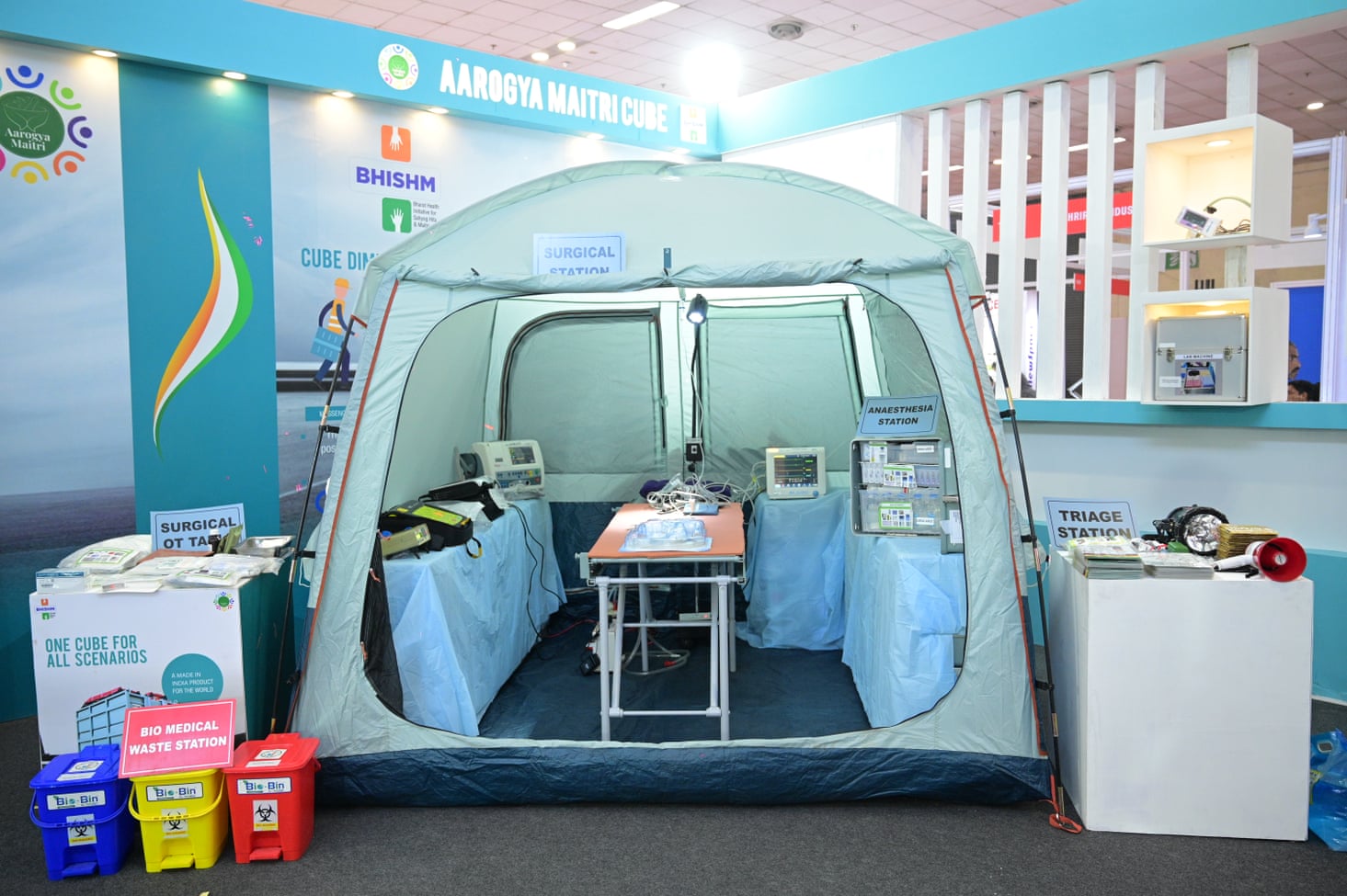
The operating theatre of the portable hospital developed by India’s health ministry. It includes a mini X-ray and ultrasound, powered by a solar-charged generator. Photograph: HLL Lifecare
Amrit Dhillon in Delhi
Fri 8 Dec 2023 00.00 EST
India has designed and built a “flatpack” field hospital that can be flown to a disaster area by helicopter and assembled faster than an Ikea bookcase.
The hospital is contained in 72 small waterproof cubes, each weighing under 15kg and measuring 38cm x 38cm x 38cm (15 x 15 x 15in). They are packed with tents and specially designed medical equipment.
The cubes can be transported to war zones or the sites of natural disaster such as floods and earthquakes in remote areas, and are tough enough to withstand being airdropped from a plane or helicopter.
It takes five trained people one hour to assemble the cubes into a fully functional hospital for doctors to treat injuries and perform life-saving surgery. Each is equipped to treat up to 200 patients.
India’s health ministry said: “It can provide critical medical care, making it a lifeline in remote and tough terrains where immediate medical attention is needed.”
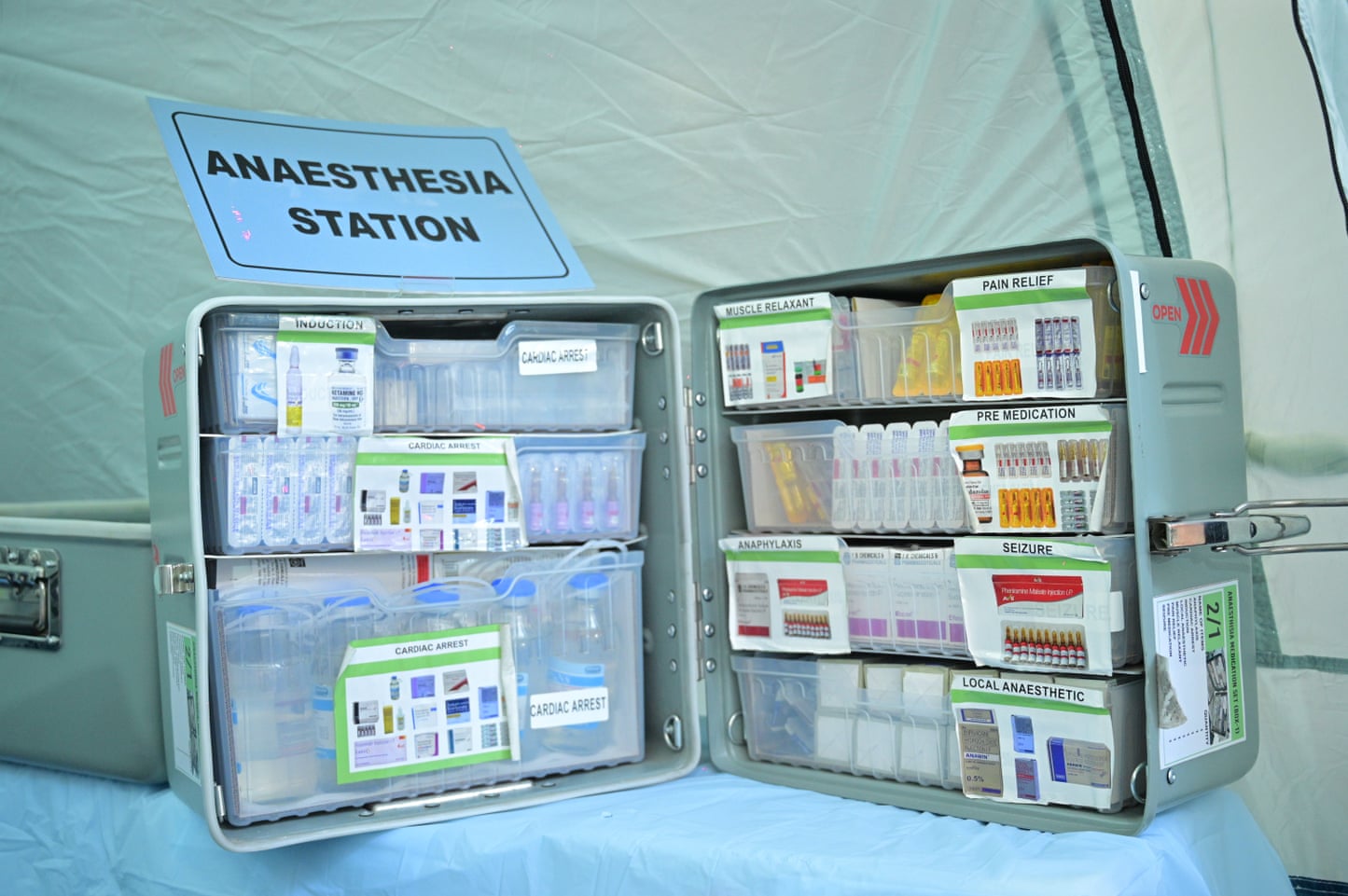
An anaesthesia pack for the hospital, with drugs for conditions such as heart attacks and seizures. Photograph: HLL Lifecare
The Aarogya Maitri Aid Cube hospital, officially launched this week, has small intensive-care units, an operating theatre and a range of equipment including portable X-ray and ultrasound machines and ventilators. It is powered by a generator charged by solar panels, and comes with water and a cooking station.
The hospital is part of an ambitious healthcare project initiated by the Indian prime minister, Narendra Modi, to support low-income countries affected by natural disasters.
The cubes’ versatility and how they can be configured is lauded by HLL Lifecare, the state-owned company behind their design.
Dr Ankita Sharma, a consultant with HLL Lifecare, said: “If the immediate need at the site is for life-saving surgery, then the operating theatre can be assembled first. This takes just 10 minutes. The doctors can start surgery while the remaining cubes are assembled.”
While the contents of 60 cubes are mandatory, the contents of the remaining 12 can be modified to suit different situations.
“If it’s an earthquake where you get lots of fractures, then you pack in more cubes containing equipment for bone injuries and remove some of the bleeding injury kits needed for soldiers with bullet or bomb injuries,” she said.
Sharma said it took a year of working with doctors, army medics, engineers and designers to come up with the blueprint.
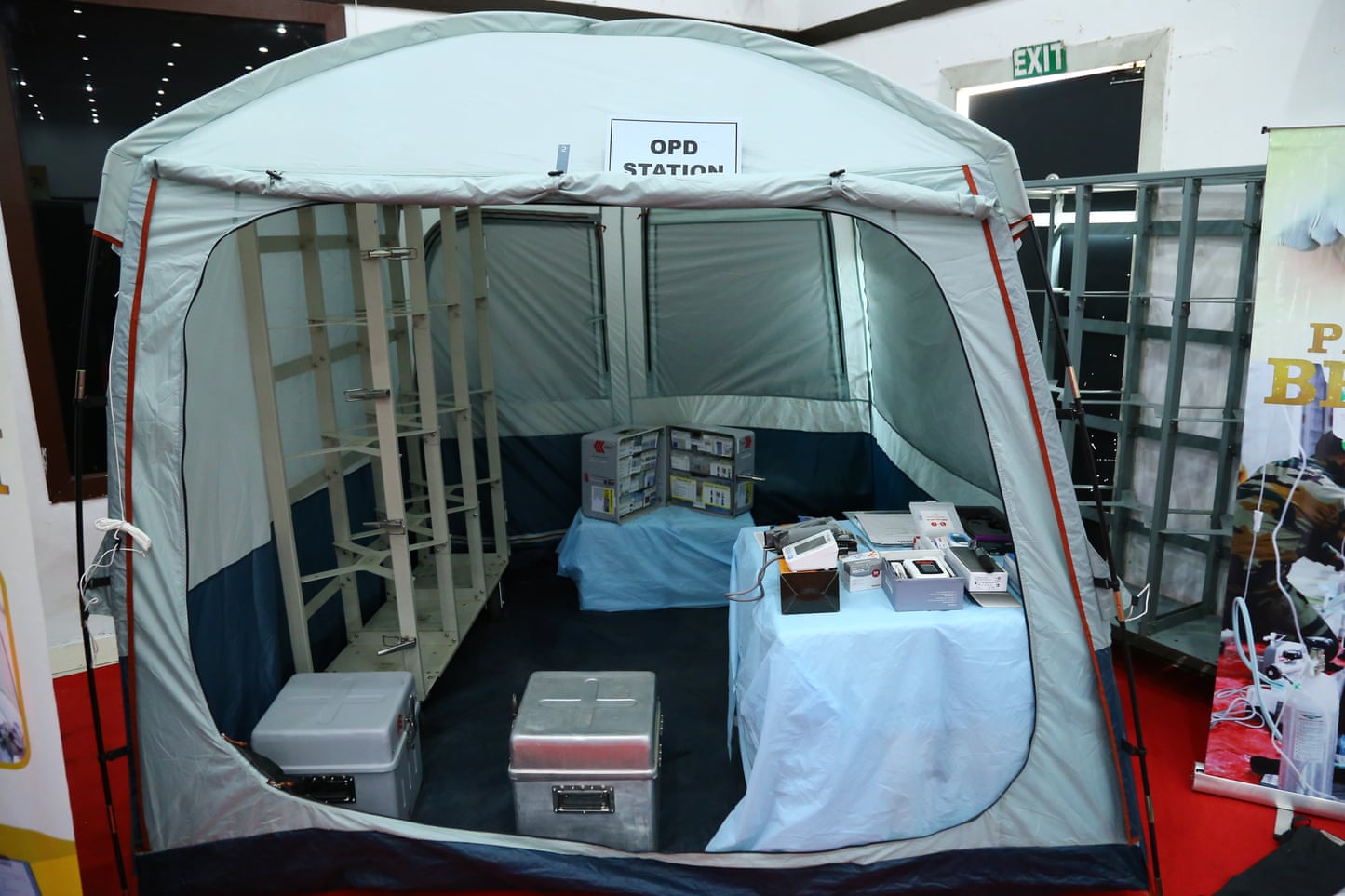
The field hospital’s ‘outpatient department’. A miniature X-ray was designed so it could fit into the small cubes. Photograph: Courtesy of HLL Lifecare
The hospital had to be small and light, which meant equipment had to be reduced in size and constantly weighed to check a helicopter could take the load.
“One of the biggest challenges was designing the X-ray machine to be smaller but we did that. But then the plate was too big. That too had to be manufactured afresh in a smaller size,” said Sharma.
Each cube is waterproof and corrosion-proof. They have been dropped from helicopters and drones to test for resilience.
A tablet computer included in the cube pack is programmed to minimise assembly errors, and an alarm sounds if the wrong equipment is put in any given cube. An app also helps users to quickly locate items in the cubes, monitor their usage and expiry dates, and ensure they are ready for subsequent deployment.
Sharma says the hospital is the first of its kind in India, but is reluctant to make any grander claim as she is not certain of similar developments in other countries.
“The hospital is a small contribution by India to humanitarian work around the world,” she said. “We are now ready to share it with any country that needs it.”
The government has given a set of the cubes to Sri Lanka and Myanmar.
India unveils flatpack field hospital that can be airdropped to disaster zones
The portable unit, comprising mini cubes of medical equipment, enables surgeons to be operating within an hour, designers claim

The operating theatre of the portable hospital developed by India’s health ministry. It includes a mini X-ray and ultrasound, powered by a solar-charged generator. Photograph: HLL Lifecare
Amrit Dhillon in Delhi
Fri 8 Dec 2023 00.00 EST
India has designed and built a “flatpack” field hospital that can be flown to a disaster area by helicopter and assembled faster than an Ikea bookcase.
The hospital is contained in 72 small waterproof cubes, each weighing under 15kg and measuring 38cm x 38cm x 38cm (15 x 15 x 15in). They are packed with tents and specially designed medical equipment.
The cubes can be transported to war zones or the sites of natural disaster such as floods and earthquakes in remote areas, and are tough enough to withstand being airdropped from a plane or helicopter.
It takes five trained people one hour to assemble the cubes into a fully functional hospital for doctors to treat injuries and perform life-saving surgery. Each is equipped to treat up to 200 patients.
India’s health ministry said: “It can provide critical medical care, making it a lifeline in remote and tough terrains where immediate medical attention is needed.”

An anaesthesia pack for the hospital, with drugs for conditions such as heart attacks and seizures. Photograph: HLL Lifecare
The Aarogya Maitri Aid Cube hospital, officially launched this week, has small intensive-care units, an operating theatre and a range of equipment including portable X-ray and ultrasound machines and ventilators. It is powered by a generator charged by solar panels, and comes with water and a cooking station.
The hospital is part of an ambitious healthcare project initiated by the Indian prime minister, Narendra Modi, to support low-income countries affected by natural disasters.
The cubes’ versatility and how they can be configured is lauded by HLL Lifecare, the state-owned company behind their design.
Dr Ankita Sharma, a consultant with HLL Lifecare, said: “If the immediate need at the site is for life-saving surgery, then the operating theatre can be assembled first. This takes just 10 minutes. The doctors can start surgery while the remaining cubes are assembled.”
While the contents of 60 cubes are mandatory, the contents of the remaining 12 can be modified to suit different situations.
“If it’s an earthquake where you get lots of fractures, then you pack in more cubes containing equipment for bone injuries and remove some of the bleeding injury kits needed for soldiers with bullet or bomb injuries,” she said.
Sharma said it took a year of working with doctors, army medics, engineers and designers to come up with the blueprint.

The field hospital’s ‘outpatient department’. A miniature X-ray was designed so it could fit into the small cubes. Photograph: Courtesy of HLL Lifecare
The hospital had to be small and light, which meant equipment had to be reduced in size and constantly weighed to check a helicopter could take the load.
“One of the biggest challenges was designing the X-ray machine to be smaller but we did that. But then the plate was too big. That too had to be manufactured afresh in a smaller size,” said Sharma.
Each cube is waterproof and corrosion-proof. They have been dropped from helicopters and drones to test for resilience.
A tablet computer included in the cube pack is programmed to minimise assembly errors, and an alarm sounds if the wrong equipment is put in any given cube. An app also helps users to quickly locate items in the cubes, monitor their usage and expiry dates, and ensure they are ready for subsequent deployment.
Sharma says the hospital is the first of its kind in India, but is reluctant to make any grander claim as she is not certain of similar developments in other countries.
“The hospital is a small contribution by India to humanitarian work around the world,” she said. “We are now ready to share it with any country that needs it.”
The government has given a set of the cubes to Sri Lanka and Myanmar.
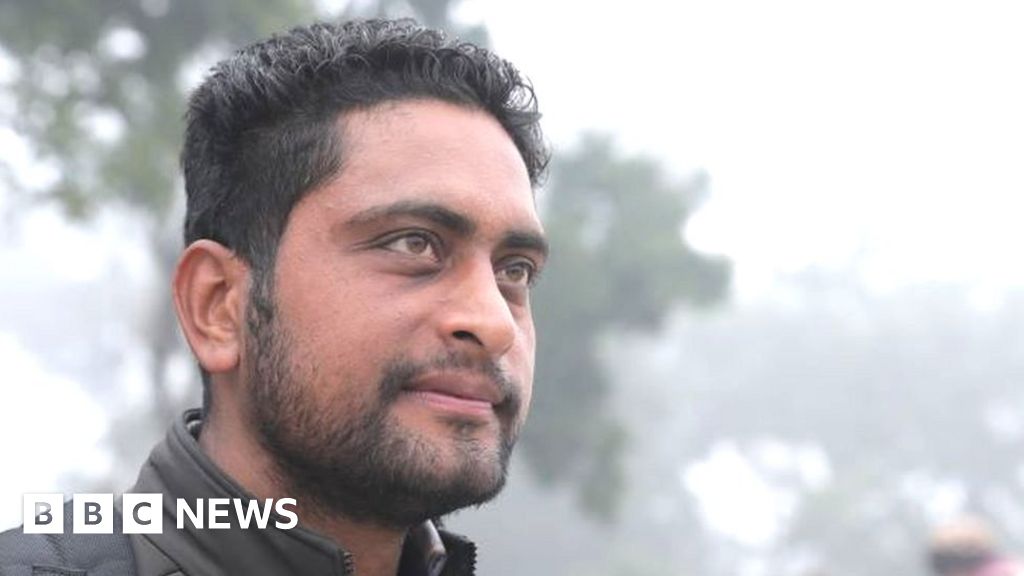
A jobs crisis in India is driving workers to Israel
The rush for construction jobs in war-torn Israel paints a grim picture of the jobs situation in India.
www.bbc.com
A jobs crisis in India is driving workers to Israel
24th January 2024, 07:21 EST
By Soutik Biswas India correspondent
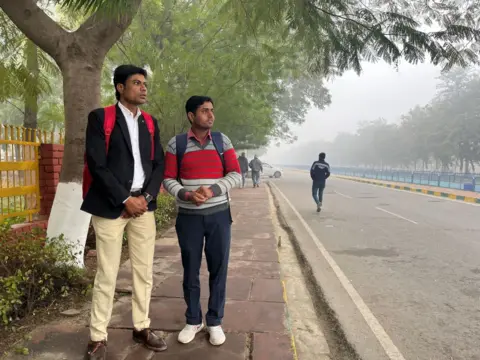
Mansi Thapliyal
Ranjeet Kumar (left) and his friend Sanjay Verma (right) are both graduates, but haven't landed a regular job
On a frigid morning last week, hundreds of men, wrapped up in woollens and blankets, queued up inside a sprawling university campus in India's northern state of Haryana.
The men, carrying backpacks and lunch bags, were queueing up for practical exams for construction jobs - plastering workers, steel fixers, tile setters - in Israel.
For those like Ranjeet Kumar - a university educated, qualified teacher who has only ever managed to find work casually as a painter, steel fixer, labourer, automobile workshop technician, and a surveyor for a non-profit - it is a chance too good to pass up.
The 31-year-old has never managed to earn more than 700 rupees per day, despite having two degrees and having cleared a government "trade test" to work as a "diesel mechanic". In contrast, the jobs in Israel are paying around 137,000 rupees ($1,648; £1,296) a month, along with accommodation and medical benefits.
Perhaps unsurprisingly then, Mr Kumar, who got a passport last year, is eager to secure a job as a steel fixer in Israel to support his seven-member family.
"There are no secure jobs here. Prices are going up. I am not financially stable even after graduating nine years ago," he said.
According to reports quoting officials, Israel plans to bring in 70,000 workers from China and India and other countries to boost its construction sector, which has been struggling since the 7 October Hamas attack. A labour shortage had arisen after Israel barred some 80,000 Palestinian workers following the attack, reports add.
Some 10,000 workers from India will reportedly be hired. Uttar Pradesh and Haryana are accepting job applications, with the Maharshi Dayanand University in Haryana's Rohtak city hosting tests for a few thousand applicants from across the country. (The Israeli embassy in Delhi refused to comment on the subject.)
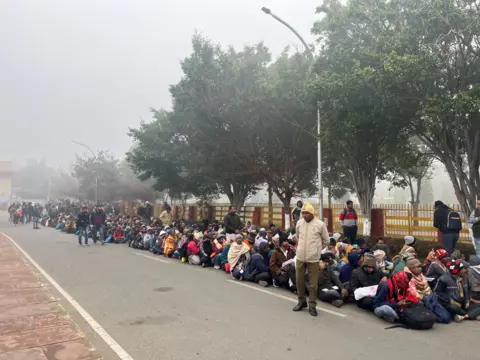
Hundreds of men queued up at a university in Haryana which hosted the exam for construction jobs in Israel
Like Mr Kumar, the job seekers in the queue are part of India's sprawling and precarious informal economy, working without formal contracts and benefits. Like Mr Kumar, many hold college degrees but are struggling to land secure jobs, and find themselves in casual construction jobs, earning up to 700 rupees a day for about 15-20 days a month. They carried their resumes - "I am a good team player with my team," said one.
Many juggle multiple jobs to augment earnings. Some attribute their financial setbacks and limited prospects to India's 2016 currency ban - or demonetisation - and the strict 2020 Covid lockdown. Others complain about question paper leaks in government exams. Many claim to have tried to pay agents to illegally enter the US and Canada but found it difficult to gather the money. All this, they said, had prompted them to look for a secure, more lucrative overseas job, "never mind the risk of working in a war zone".
Sanjay Verma, who also graduated in 2014, obtained a technical education diploma, and spent six years attempting over a dozen government exams for positions in the police, paramilitary and railways. ("There are very few jobs, and the demand is 20 times their number," he said). In 2017, he failed to pay up 140,000 rupees to an agent for a promised 900 euro-per-month farm job in Italy.
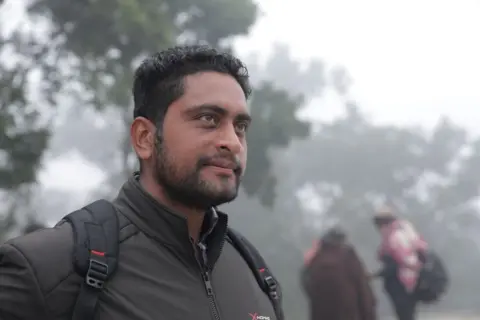
Harsh Jat, a graduate, drove a police ambulance and worked as a bouncer in a pub
Parbat Singh Chauhan said he had slipped back into uncertainty after the twin shocks of the currency ban and the pandemic lockdown. The 35-year-old from Rajasthan worked as a emergency ambulance driver, earning 8,000 rupees a month for a 12-hour daily job. He also undertook small construction contracts in his village, and even bought six cars for taxi rentals.
Mr Chauhan, like many others, commenced his journey after completing high school. He began as a newspaper hawker in school, earning 300 rupees a month. After his mother died, he worked in a clothes shop. When he didn't find a decent job, he did a course in repairing mobile phones. "But that didn't help much," he said.

Mansi Thapliyal
Shubham Bhoi graduated two years ago and remains unemployed - he has applied for a construction job in Israel
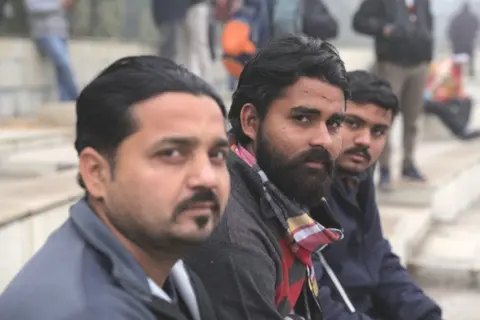
Mansi Thapliyal
Ankit Upadhyay (middle) spent eight years in Kuwait working as a steel fixer before he lost his job during the pandemic
For five to seven years until 2016, his fortunes improved: he drove an ambulance, managed small village construction contracts and ran his fleet of taxis.
"But the lockdown [in 2020] destroyed me. I had to sell my cars as I couldn't afford the mortgage. Now I am back to driving an ambulance and taking small government construction contracts," he said.
There are others like Ram Avatar, a 40-year-old tile setter from Haryana with two decades of experience. Faced with the challenges of a rising cost of living and stagnant wages, he worries about funding the higher education of his children - his daughter is pursuing a bachelor's in science, while his son aspires to become a chartered accountant. He tried for jobs in Dubai, Italy, and Canada but couldn't afford the exorbitant fees demanded by agents. With expenses for rent, his children's coaching, and food, he says he's struggling.
"We know there's a war going on in Israel. I am not afraid of death. We can die here too," he said.
Then there's the rising tide of aspiration. Harsh Jat, 28, earned a humanities degree in 2018. Initially a mechanic in a car factory, he later spent two years as a police vehicle driver, growing weary of dealing with "intoxicated people misusing the emergency line". Subsequently, he worked as a pub bouncer in the upscale suburb of Gurgaon, earning 40,000 rupees. "These jobs, they throw you out after two years and there's no security," he told me.
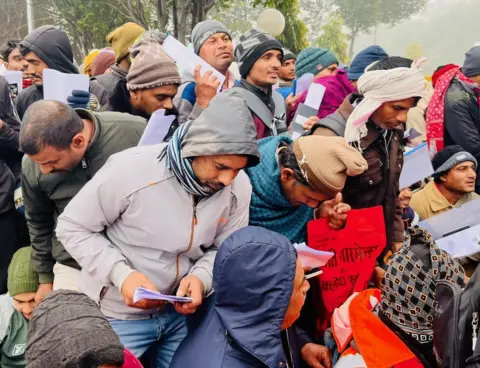
Mansi Thapliyal
Thousands of job seekers are braving the inclement weather to try their luck for Israel
Mr Jat, jobless, returned to his family's eight-acre farm. "But nobody wants to farm now," he said. He tried government jobs - clerk, policeman - without success. He said young men in his village have paid agents 6m rupees each to illegally enter US and Canada. They were sending remittances home, funding their families' acquisition of fancy cars.
"I want to go abroad and get a good, well-paying job because when I have a child he will ask me, 'why does my neighbour have a swanky SUV, and we don't'?" said Mr Jat.
"I am not scared of the war."
The jobs scene in India presents a mixed picture. Government data from its Periodic Labour Force Survey, shows a declining trend in joblessness - from 6% in 2017-2018 to 4% in 2021-2022. Santosh Mehrotra, a development economist and visiting professor at the University of Bath, attributes this to the inclusion of unpaid work as jobs in government data.
"It's not that jobs are not happening. It's just that organised jobs are barely growing and at the same time, the number of young people looking for jobs is increasing," said Prof Mehrotra.
Unemployment is falling but remains high, according to the latest State of Working India report, by Azim Premji University. After stagnating since the 1980s, the share of workers with regular wages or salaried work had begun increasing in 2004 - 18 to 25% for men and 10 to 25% for women, according to the report. Since 2019, however, the pace of regular wage jobs had decreased due to a "growth slowdown and the pandemic".
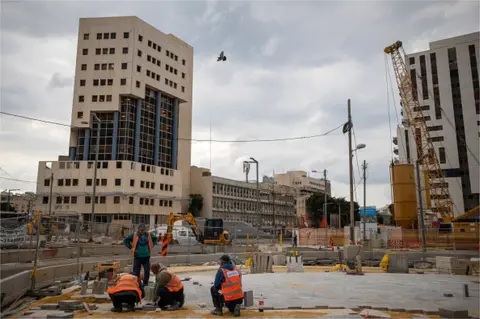
Getty Images
Reports say Israel plans to bring in 70,000 workers from other countries to boost its construction sector
The report found that above 15% of graduates - and a massive 42% for graduates under 25 years old - had no jobs in the country after the pandemic. "This group has aspirations for higher incomes, and they don't want to do insecure gig work. This group is trading that extreme risk [of going to Israel] for higher incomes and some level of reduced precarity," said Rosa Abraham, a labour economist with Azim Premji University.
One of them is Ankit Upadhyay from Uttar Pradesh. He said he paid an agent, got a visa and spent eight years in Kuwait working as a steel fixer before losing his job during the pandemic.
"I have no fear left. I want to work in Israel. I don't mind the risks there. There's no job security at home," he said.
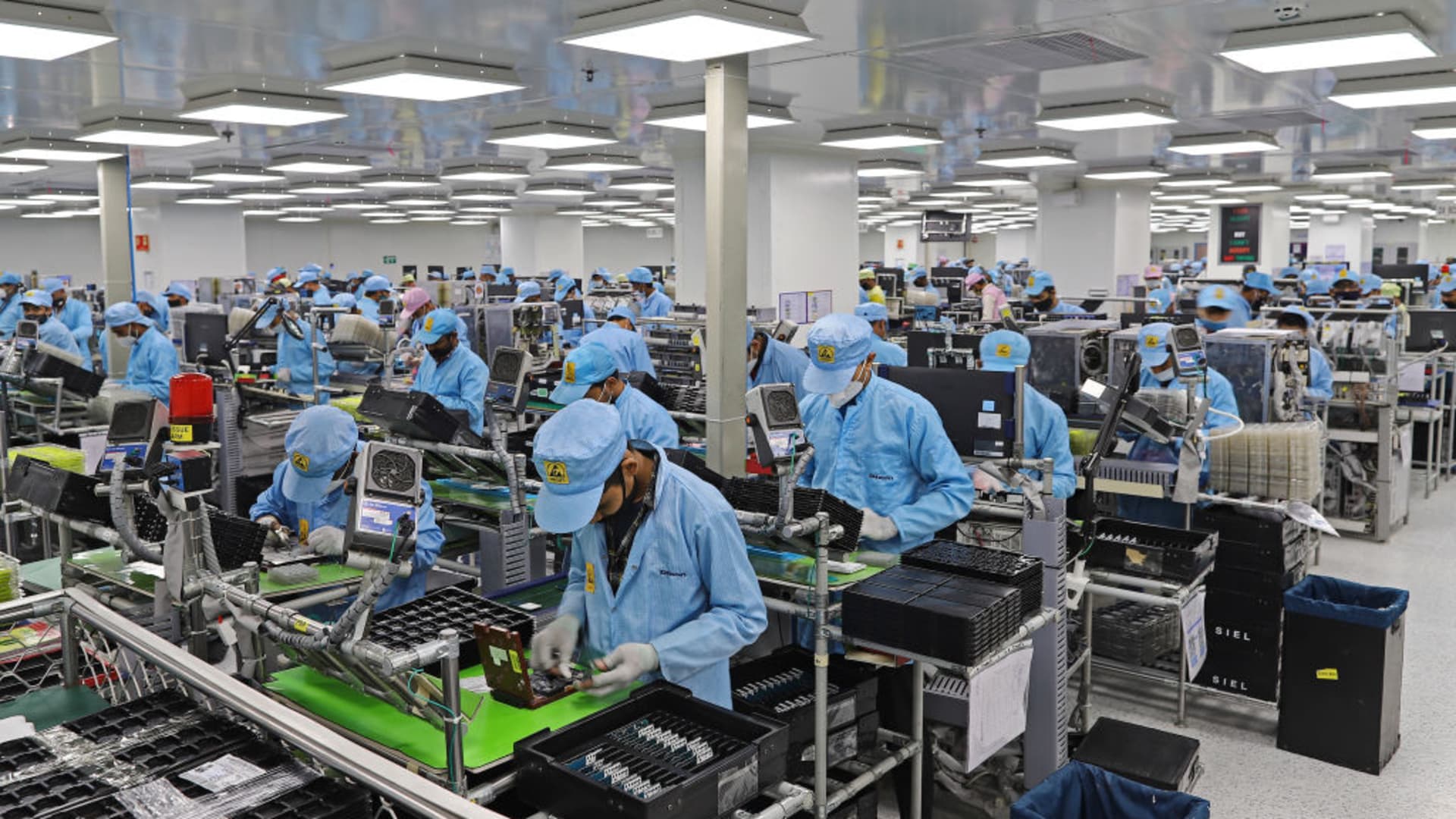
China is 'risky' for supply chains and India a favored destination for U.S. firms, survey shows
Of the 500 executive-level U.S. managers surveyed by market research OnePoll, 61% said they would pick India over China if both could manufacture the same materials.
India deploys unprecedented naval might near Red Sea to rein in piracy
Krishn KaushikJanuary 31, 20248:40 AM ESTUpdated 4 hours ago
Indian Foreign Minister Subrahmanyam Jaishankar visits Tehran
Iran's Foreign Minister Hossein Amir-Abdollahian meets with Indian Foreign Minister Subrahmanyam Jaishankar, in Tehran, Iran January 15, 2024. Majid Asgaripour/WANA (West Asia News Agency) via REUTERS/File Photo Acquire Licensing Rights
NEW DELHI, Jan 31 (Reuters) - India has deployed at least a dozen warships east of the Red Sea to provide security against pirates and has investigated more than 250 vessels as Western powers focus on attacks by Yemen's Iran-backed Houthis, Indian officials said.
India has not joined the U.S.-led task force for the Red Sea and does not have any warships there. But it currently has two frontline warships in the Gulf of Aden and at least 10 warships in the northern and western Arabian Sea, along with surveillance aircraft, the officials said.
This is India's largest deployment in the region, they said.
Foreign Minister Subrahmanyam Jaishankar said India's growing capability, interests and reputation warranted its help in difficult situations.
"We will not be considered a responsible country when bad things are happening in the surrounding country and we say 'I have got nothing to do with this',” he said at a public event on Tuesday.
Other countries have a naval presence in the region, including the United States, France and China, but Indian officials say India's presence is the largest.
Indian military and defence officials said that navy personnel, including special commandos, have investigated more than 250 vessels and small boats in the last two months, boarding more than 40, as piracy returns after a six-year absence.
At least 17 incidents of hijacking, attempted hijacking and suspicious approaches had been recorded by the Indian Navy since Dec. 1, they said.
Yemen's Houthis have since November attacked ships in the Red Sea, part of a route that accounts for about 12% of the world's shipping traffic, in what they say is an effort to support Palestinians in the war with Israel.
A U.S.-led task force is protecting vessels within the Red Sea and launched attacks across Yemen targeting Houthi forces this month.
But Indian experts said that the conflict is spilling beyond the Red Sea.
"Houthis and piracy are disconnected. But pirates are trying to use this opportunity as the West's efforts are focused on the Red Sea," a navy official said on condition of anonymity.
An Indian Navy spokesperson did not respond to a request for comment.
The Indian Navy is doing classic police work, Harsh Pant, a foreign policy expert at the New Delhi-based Observer Research Foundation think tank, said.
It rescued two Iranian and helped rescue a Sri Lankan fishing vessels in the first two days of this week. In December, it helped two merchant vessels targeted by aerial strikes close to India's Exclusive Economic Zone.
Two Indian officials said that Iran-made Shahed 136 drones were used in the December attacks without blaming Tehran, which had immediately dismissed U.S. accusations linking it to those attacks. Jaishankar visited Iran this month and raised the issue of maritime security.
"As a regional security provider, (the Indian Navy) is increasingly showcasing the ability to be able to protect not only its interests but also give confidence to regional players that it is willing and able to shoulder regional responsibility," Pant said.
Reporting by Krishn Kaushik; Editing by Nick Macfie
Our Standards: The Thomson Reuters Trust Principles.
Acquire Licensing Rights


Wall Street Snubs China for India in a Historic Markets Shift
Investors are paying close attention to the contrasting trajectories of two of Asia’s greatest powers.
@88m3 @ADevilYouKhow @wire28 @dtownreppin214 @Leasy @Neo The Resurrected ONE @MAKAVELI25
@wire28 @BigMoneyGrip @Dameon Farrow @re'up @Blackfyre @NY's #1 Draft Pick @Skyfall @2Quik4UHoes
Last edited:
Neo. The Only. The One.
THE ONE
The jokes write themselves. Why do you do this to yourself, Nap?